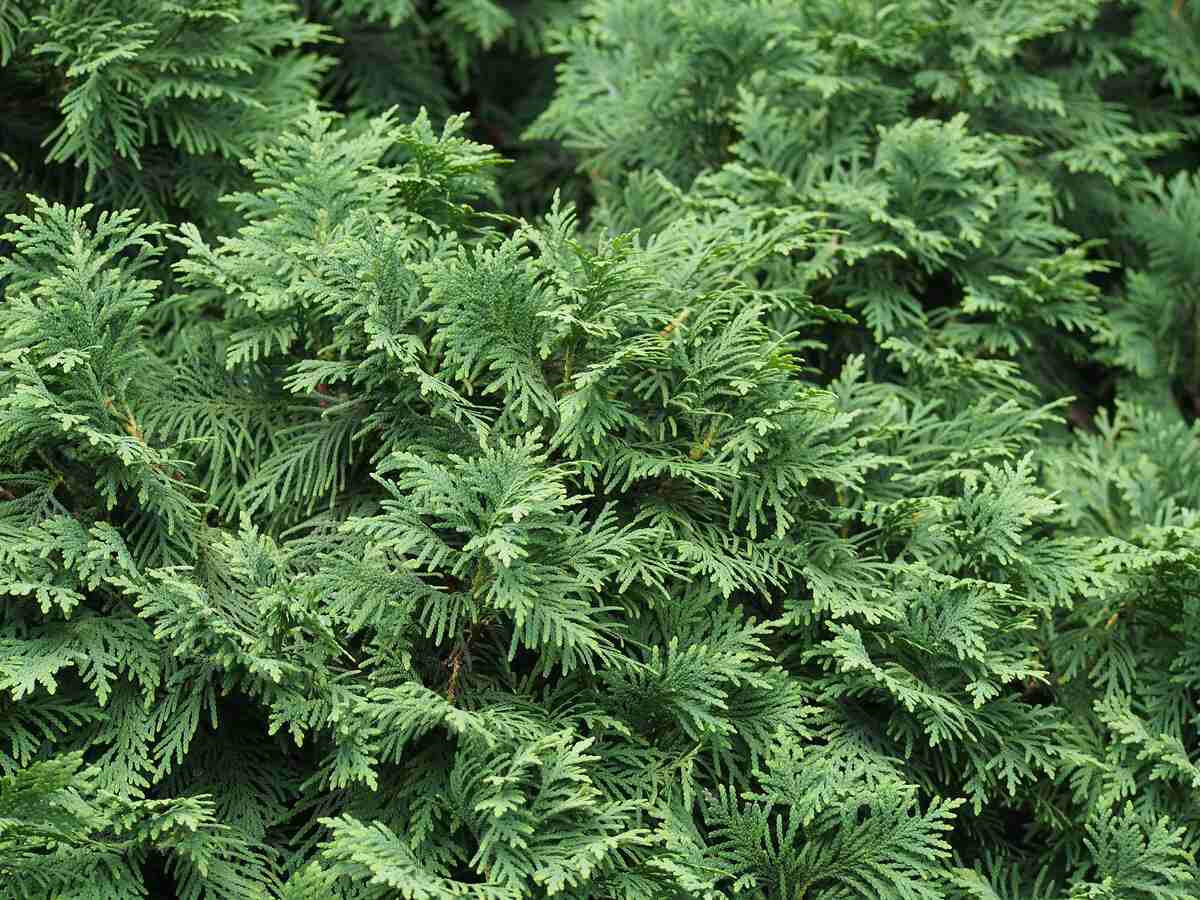
Commonly called privacy hedges, living fences can do more than provide a barrier to neighbors’ prying eyes. These are the 11 best privacy hedges to consider if you want to plant hedges for screening, security, or simply to create a secluded enclave in your backyard.
- What Makes a Good Privacy Hedge?
- Evergreen Privacy Hedges
- 1. American Arborvitae: Best for Year-Round Privacy
- 2. Chindo Viburnum: Best for a Fast-Growing Hedge
- 3. American Holly: Best for Wildlife Gardens
- 4. Manhattan Euonymus: Best for Partial Shade
- 5. Leyland Cypress: Best for Tall Hedges
- 6. Schipka Cherry Laurel: Best for Low Maintenance
- 7. Southern Red Cedar: Best for Windbreaks
- 8. Wintergreen Boxwood: Best for Small Gardens
- 9. Yew Plum Pine: Best for Drought Tolerance
- Deciduous Privacy Hedges
- How to Plan and Plant Privacy Hedges
- FAQ
What Makes a Good Privacy Hedge?
Whether you opt for the continuous coverage of evergreens, the three-season beauty of the deciduous, or a mix of the two, good hedges for privacy should meet your goals while balancing what your plants need.
A beautiful living privacy fence made of rows of densely planted bushes offers:
- A fast-growing boundary: This allows you to quickly remodel your landscape to define property lines and protect yourself from nosy neighbors.
- Noise reduction: A living fence can drastically reduce noise pollution from traffic or neighbors. Choose a cultivar that will reach the height you’re looking for.
- A windbreak: Limit the wind and protect your home from blowing snow to reduce your heating bill. Blocks the hot summer wind, reducing the evaporation rate and saving water.
- Natural habitat restoration: Provides much-needed breeding, foraging, and shelter for mammals, birds, and beneficial insects.
- Erosion control: Root systems work together to control erosion in your yard.
- Improved curb appeal: An elegant landscape feature that will ultimately fill the space, create a beautiful privacy screen, and increase your home’s value.
Evergreen Privacy Hedges
Installing a fence can perform many of the same functions as a hedge, but walls aren’t the same as living natural barriers. We asked experts to name some of the best hedges for privacy that can balance fast growth, hardiness, and beauty. Here’s what they said.
1. American Arborvitae: Best for Year-Round Privacy
Thuja occidentalis
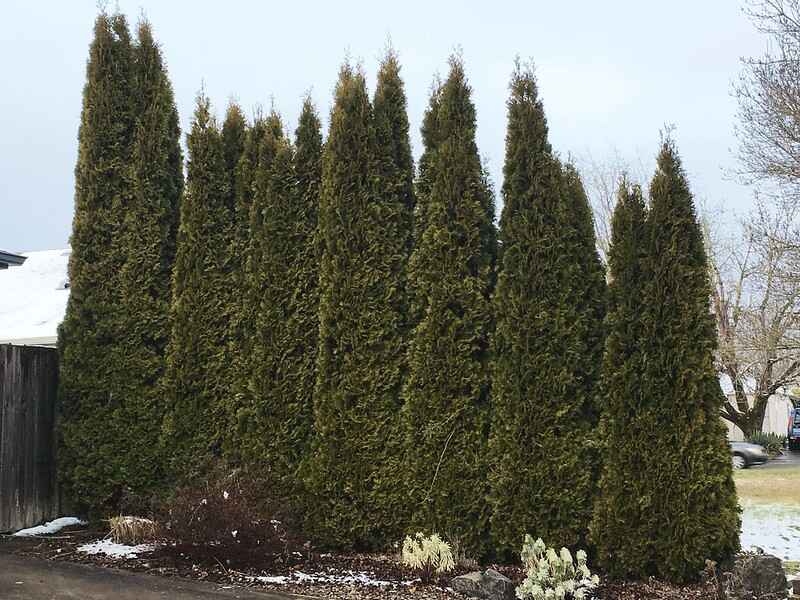
Photo Credit: Oregon State University / Flickr / CC BY-SA 2.0
American arborvitae is an evergreen shrub or tree that comes in many heights, from smaller ‘Emerald Green’ arborvitae (Thuja occidentalis ‘Smaragd’) to the towering ‘Green Giant’. Due to their low maintenance and evergreen foliage, American arborvitae cultivars are among the best and most popular year-round privacy hedges for home landscapes.
Arborvitae have flat, needle-like leaves that produce thick green foliage. The reddish-brown bark of the Thuja occidentalis species has peeling plates and furrows. Many American arborvitae varieties are native to North America and can grow rounded, straight, thin, pyramidal, or columnar.
Ideal for: Privacy screens, borders, hedges, windbreaks, and foundation plants, especially the smaller cultivars. Both American and giant arborvitae are popular landscaping plants for above-ground swimming pools.
Growth rate: Slow
Maintenance: Prune arborvitae so that the top is narrower than the base. Many upright varieties have a natural cone shape and don’t need pruning. Arborvitae have shallow roots and require approximately 1 inch of water each week.
Growing notes: Evergreen. Tree spacing for most cultivars is roughly 6 feet for a single line of arborvitae to create a formal design but a sparse privacy screen. For a dense, thick hedge, space the arborvitae trees in double rows about 9 feet apart.
- Hardiness zones: 3-7
- Sun: Needs full sun but will grow in partial shade
- Soil: Prefers neutral to alkaline and moist, well-drained soil
- Mature Size: Depends on variety; 2-50 feet tall, 4-15 feet wide
- Flowers/fruit: Non-flowering
- Drought Tolerant: No
- Possible problems: Leaf blight, canker, bagworms, mealybugs, scales, and spider mites on occasion. Damage from ice or snow buildup.
2. Chindo Viburnum: Best for a Fast-Growing Hedge
Viburnum awabuki ‘Chindo’

With fragrant late-spring flowers, fall fruit, and evergreen foliage, you’ll enjoy four seasons of interest from this attractive hedge that grows incredibly fast. From shrubs he found on the South Korean island of Chindo in 1985, J.C. Raulston of the North Carolina State University Arboretum collected this variety of Viburnum awabuki.
Viburnum awabuki are evergreens with dense coverage, glossy leaves, and white blossoms that lead to vivid red berries in the fall that can make your flowerbed pop.
Ideal for: Hedges, screens, barriers, foundations, borders, or open woodland areas
Growth rate: Fast
Maintenance: Water your sweet viburnum about once a week so that the first 3 inches of the soil are moist. Pruning in late winter or early spring will help shape your hedge, and fertilizing in the early spring is ideal.
Growing notes: Evergreen. Find out the mature width of the viburnum variety you select. Divide the mature width by two and plant your viburnum shrubs that distance apart.
- Hardiness zone: Grows best in planting zones 7 to 11
- Sun: Needs full sun, tolerates partial shade well
- Soil: Prefers good drainage but is tolerant of most soil conditions
- Mature size: Can quickly reach 12 feet tall and 8 feet wide
- Flowers/fruit: Clusters of tiny white flowers that develop into bright red berries in early autumn
- Drought tolerant: Yes, once established
- Possible problems: Aphids, spider mites, and thrips may feed. There can be leaf spots, powdery mildew, and downy mildew.
3. American Holly: Best for Wildlife Gardens
Ilex opaca
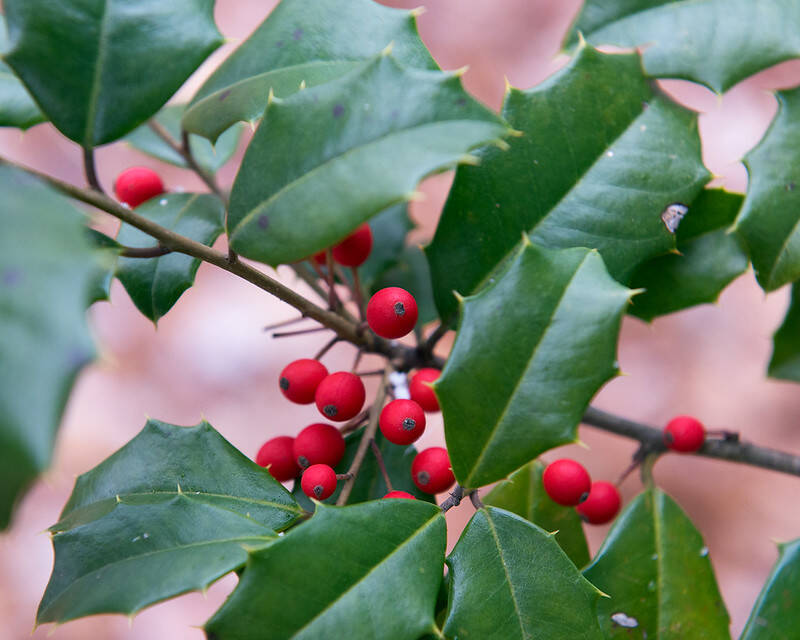
Photo Credit: Plant Image Library / Flickr / CC BY-SA 2.0
People like to use American holly as an ornamental hedge when landscaping for privacy or as an addition to their wildlife garden. (Its bright red berries attract songbirds.) Toothed green leaves and red berries make this a popular choice. In addition, the dense, evergreen foliage is easy to maintain, requires infrequent pruning, and is used in landscaping to block noise.
The United States Department of Agriculture’s (USDA) plants database lists dozens of varieties of holly.
Ideal for: An ornamental or privacy hedge
Growth rate: Slow
Maintenance: When planting Ilex opaca, keep them away from harsh, arid winter winds. Keep the soil moist and only prune them if you want to shape them into a hedge or if its branches begin to grow unevenly.
Growing notes: Evergreen. Planting American holly is simple if you use plants from containers or plants that are balled or in burlap. It’s not recommended to plant holly with bare roots. They are a good option for low-maintenance shade landscaping.
- Hardiness zone: 5-9
- Sun: Performs well in shade or full sun
- Soil: Prefers sandy, acidic to alkaline soil with good drainage
- Mature size: Untrimmed: 40-60 feet tall and up to 20 feet wide
- Flowers/fruit: Berries in shades of orange and red emerge among green leaves from September to February.
- Drought tolerant: Yes (some varieties)
- Possible problems: They are resistant to most pests and illnesses.
Hollies in history: The Yaupon holly (Ilex vomitoria) is the only caffeine-containing plant native to North America and was used in purging rites by Native Americans.
4. Manhattan Euonymus: Best for Partial Shade
Euonymus kiautschovicus ‘Manhattan’
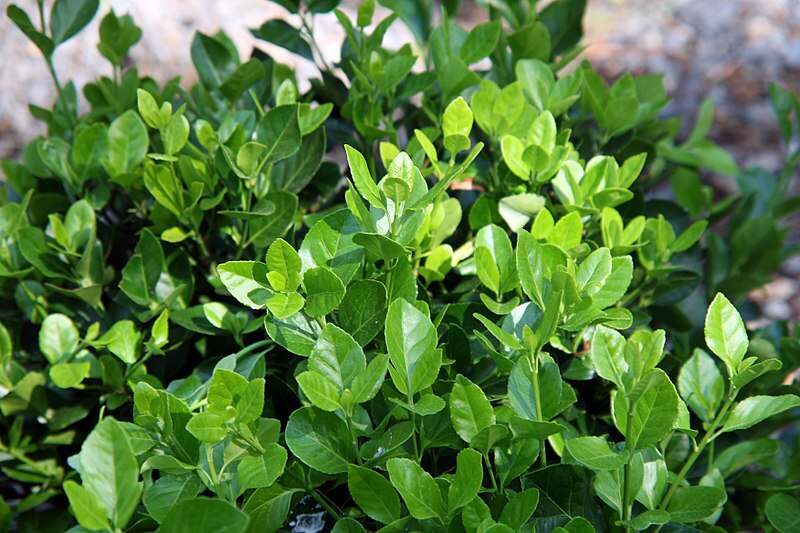
Photo Credit: David J. Stang / Wikimedia Commons / CC BY-SA 4.0
‘Manhattan’ euonymus is an evergreen commonly seen in the famous hedges of the Hamptons. Maintaining it will result in a tight, dense hedge that will achieve some height. Its foliage is evergreen in warm winter regions and semi-evergreen to deciduous in cold winter climates (USDA Zones 5 and 6). If you have light shade in your yard, ‘Manhattan’ euonymus is the best hedge for partial shade.
Euonymus kiautschovicus is a broadleaf, rounded shrub with greenish-white blossoms native to Japan. The flowers attract pollinators, and pink berries turn red in the fall. The ‘Manhattan’ cultivar was developed in Manhattan, Kansas.
Ideal for: Borders, hedges, privacy screens, topiary, and barriers
Growth rate: Fast
Maintenance: Keep them regularly trimmed. ‘Manhattan’ euonymus shrubs need only a small amount of water once established, except during a prolonged drought.
Growing notes: Evergreen. To establish a hedge, plant the Euonymus kiautschovicus about 3 feet apart. Adding a 2 to 3-inch layer of organic mulch after planting is recommended. The North Carolina State University Cooperative Extension found the ‘Manhattan’ cultivar has good resistance to the potentially fatal euonymus scale.
- Hardiness zone: 5-8
- Sun: Full sun to partial shade
- Soil: Prefers well-drained soil of almost any type
- Mature size: 4-6 feet tall, 3-5 feet wide
- Flowers/fruit: Small greenish-white flowers appear in late summer. The pinkish fruit capsules develop in late autumn, opening to reveal orange seeds.
- Drought tolerant: Yes, once established
- Possible problems: Anthracnose, crown gall, leaf spot, mildew, and aphids are possible issues
5. Leyland Cypress: Best for Tall Hedges
x Hesperotropsis leylandii (previously known as x Cuprocyparis leylandii)
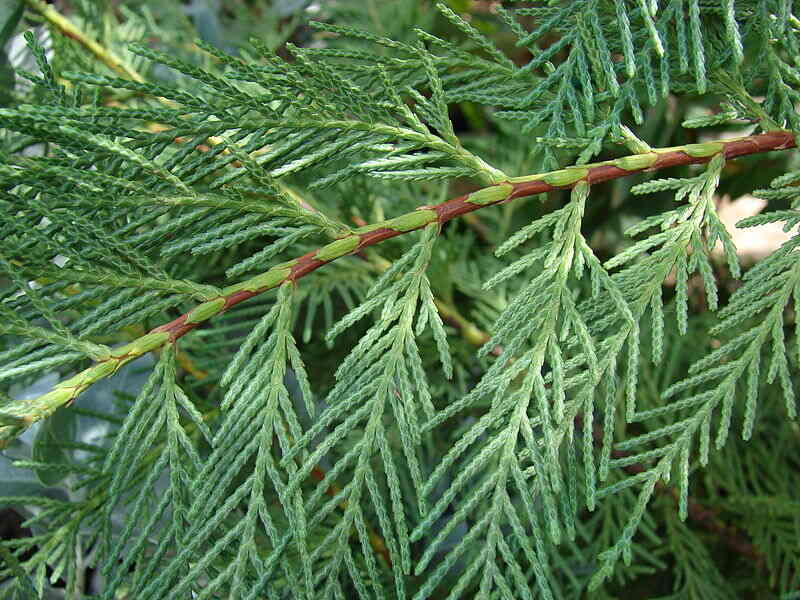
Photo Credit: Forest & Kim Starr / Wikimedia Commons / CC BY 3.0
The popular Leyland cypress makes an excellent tall hedge or tree for privacy and tops the fast-growing wishlist. This hybrid evolved naturally through cross-pollination, particularly in the United States and Western Europe.
It’s a coniferous, evergreen tree with a conical shape and a “lighter, lacier” look, says Lisa Mierop, principal of Mierop Design in Montclair, N.J. Dark green to bluish-green needles of Leyland cypress are scale-like and flat against evergreen sprays. In addition to providing birds with wintertime cover, they come in more than 30 varieties.
Ideal for: Privacy screens, hedges, and windbreaks.
Growth rate: Fast
Maintenance: For the first month, water your freshly planted Leyland cypress multiple times each week while the root system develops. Water established trees every week or every two weeks, depending on the weather. Trim the top and sides up to three times during the growing season (April through August).
Growing notes: Evergreen. Divide your desired hedge height by four. Plant the trees 3 feet apart for a 12-foot tall hedge for privacy.
Leyland cypress can grow quickly and may intrude on your neighbors’ yards. Plus, they easily become top-heavy and may be damaged by heavy snow. Mierop says, “They can, however, be kept sheared into a tight hedge, with maintenance pruning essential.”
- Hardiness zone: 6-10
- Sun: Needs full sun, tolerates partial shade
- Soil: Prefers a pH range between 5.0 and 8.0, and will thrive in most soils
- Mature size: Grown as a hedge, 10 to 15 feet high. On its own, 60-70 feet tall and 10-15 feet wide.
- Flowers/fruit: Non-flowering, produces cones
- Drought tolerant: No
- Possible problems: No significant issues. Possibility of common tree fungus issues like canker or root rot. Watch for bagworms and deer.
6. Schipka Cherry Laurel: Best for Low Maintenance
Prunus laurocerasus ‘Schipkaensis’
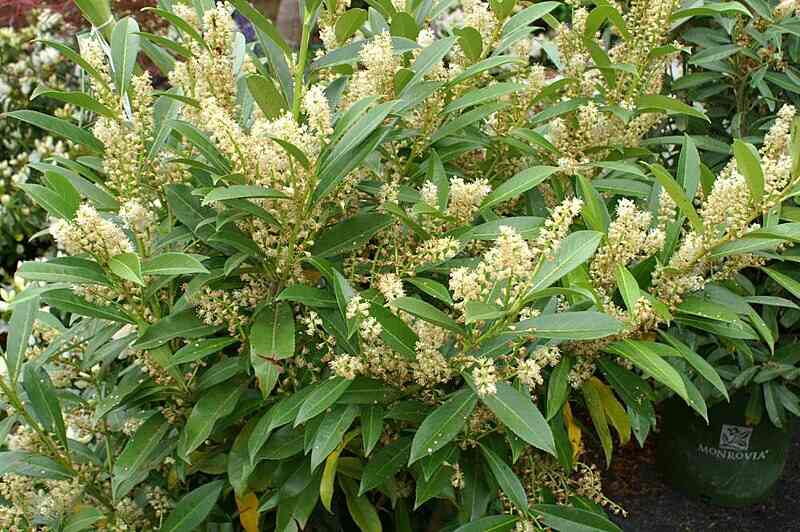
Photo Credit: David Stang / Wikimedia Commons / CC BY-SA 4.0
Cherry laurels are small trees and shrubs native to southeast Europe and southwest Asia. ‘Schipkaensis,’ a popular and low-maintenance laurel cultivar, is a goblet-shaped, upright evergreen shrub or small tree. This shrub’s thick foliage provides cover and nesting sites for songbirds and is deer-resistant.
Green, glossy leaves alternate along the stems and provide a backdrop for loose clusters of five-petaled white flowers in the spring. The fruit is a purple-black drupe but is not safe to eat. Doctors advise watching kids or pets around a cherry laurel plant, as every part of it is poisonous if eaten.
Ideal for: Tall hedges, privacy screens, mass planting, shady areas, or in a backyard wildlife habitat
Growth rate: Medium
Maintenance: Prunus laurocerasus will grow in most soil types, but it’s ideal if the soil is rich in organic matter, moist, and has sufficient drainage. Pruning cherry laurel shrubs is best done immediately after flowering is done in late spring, but you can prune up to two months before your first hard freeze.
Growing notes: Evergreen. Plant the shrubs 3 feet apart to make a cherry laurel hedge. The branches will quickly intertwine, forming a thick barrier.
- Hardiness zone: Grows best in planting zones 5-9
- Sun: Needs full sun, tolerates partial shade
- Soil: Prefers well-drained, organic-rich soil of most types
- Mature size: 10-15.5 feet tall, 5-7 feet wide
- Flowers/fruit: In spring, clusters of five-petaled, white flowers up to 6 inches long develop.
- Drought tolerant: No
- Possible problems: Susceptible to shot-hole disease, powdery mildew, and root rot. Higher pest resistance than most Prunus species.
7. Southern Red Cedar: Best for Windbreaks
Juniperus virginiana var. silicicola
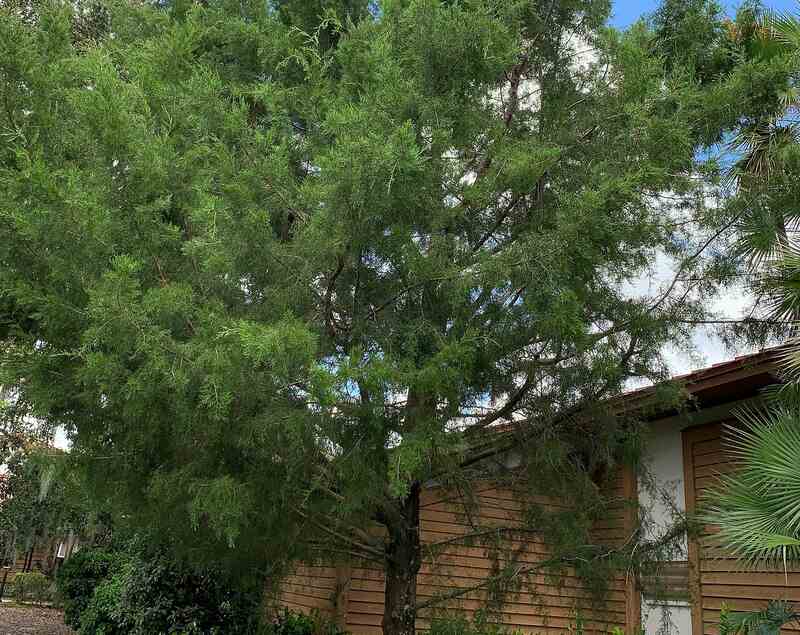
Photo Credit: KATHERINE WAGNER-REISS / Wikimedia Commons / CC BY-SA 4.0
Southern red cedars are native to North America but aren’t actual cedar trees. They’re members of the juniper family, a species recognized for its ease of care. Southern red cedar trees are common in coastal areas of the Southeast and are often used as windbreaks on large properties. In its native Florida, it is even used as a Christmas tree.
Red cedar trees feature velvety, delicate, emerald-green leaves that provide a thick, evergreen canopy and protection for wildlife. The berries attract songbirds, and the red-brown bark is fibrous and often peels.
Lloyd Singleton, Director of the New Hanover County Agricultural Extension in North Carolina, says that in addition to repelling deer and insects, the southern red cedar is “tough, totally adapted to regional conditions, and it’s really pretty with great berries that birds love, and flowers that attract bees and butterflies … with a nice aroma to boot.”
Ideal for: Privacy screens, hedges, wildlife habitat, and windbreaks
Growth rate: Medium
Maintenance: Water your red cedar at planting and then daily for the first one to two weeks. Water every two to three days for the next 12 weeks and finally once a week until roots are established.
After that, the tree can be largely neglected in terms of upkeep. It won’t need trimming unless you want to keep a specific shape, like a Christmas tree.
Growing notes: Evergreen. Seedlings or very young plants, less than one foot tall, are best spaced 8 to 18 inches apart. Larger plants, typically offered in 3-gallon pots or bigger, need a space of 5 to 7 feet apart. Juniperus virginiana var. silicicola has a northern cousin, the eastern cedar, which is good in zones 4-9.
- Hardiness zone: 7-11
- Sun: Needs full sun
- Soil: Prefers well-drained, sandy soils but is tolerant of most soil types
- Mature size: 30 to 45 feet tall, up to 30 feet wide
- Flowers/fruit: Female trees produce little (0.25-inch), fleshy, berry-like cones in the spring. The “berries” are blue with an off-white blossom.
- Drought tolerant: Yes
- Possible problems: The serious disease of cedar apple rust, which affects apples, hawthorns, and pears, has red cedar as a secondary host. It is not a good idea to plant red cedars when you have these fruit trees in your yard.
8. Wintergreen Boxwood: Best for Small Gardens
Buxus sinica var. insularis ‘Wintergreen’
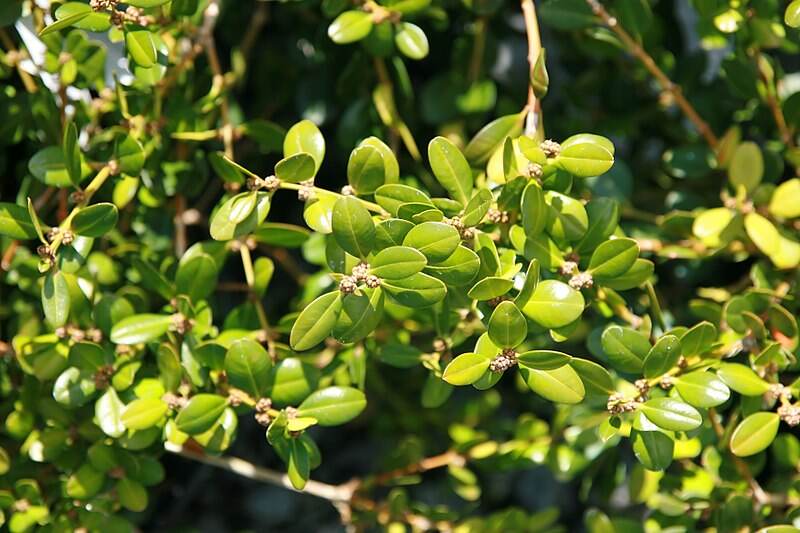
Also known as Korean boxwood, this ‘Wintergreen’ boxwood shrub is a robust cultivar that works well in colder locations because it is less likely to yellow during the winter. Its cold hardiness and short height make it a popular choice for homeowners in northern climates who want a low hedge or layered privacy fence.
As an evergreen with a very compact, dense growth habit, ‘Wintergreen’ boxwoods have small, broad, yellow-green to medium-green leaves throughout the year. This privacy shrub has tiny, but highly fragrant flowers.
Ideal for: Privacy screens, container gardens, borders, or in a rock garden
Growth rate: Moderately slow
Maintenance: Water once or twice a week until established, except during drought or extreme heat. Wintergreens will naturally grow into compact tufts of green if not trimmed.
Growing notes: Evergreen. When grown as a hedge, space plants 3.5 to 4 feet apart, center to center. Spread a 2- to 3-inch-deep layer of mulch 12 inches away from the stem base.
- Hardiness zone: 4-9
- Sun: Needs full sun, will grow in partial shade
- Soil: Prefers moist, sandy loam with good drainage; pH between slightly acidic to slightly alkaline.
- Mature size: 2-4 feet tall, 3-5 feet wide
- Flowers/fruit: In the spring, tiny greenish-yellow blooms appear.
- Drought tolerant: No
- Possible problems: Diseases like blight and leaf spots occasionally arise. In poorly drained soils, root rot may pose a problem.
9. Yew Plum Pine: Best for Drought Tolerance
Podocarpus macrophyllus
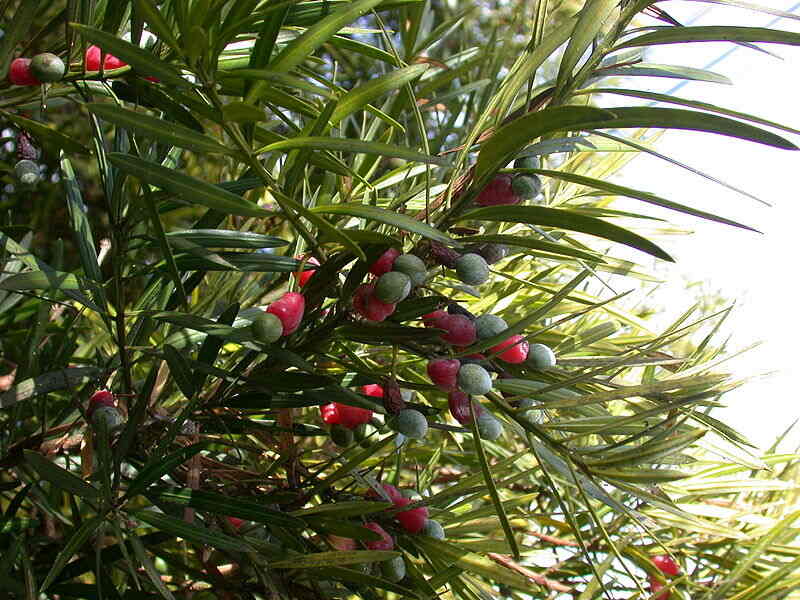
Yew plum pines are slow-growing, coniferous evergreen shrubs or conical trees with needle-like leaves. This shrub can be pruned regularly to create a soft, low-maintenance hedge with dense, dark green foliage but no flowers. Yew plum pines are ideal for drought-prone areas as they are very drought tolerant once established.
This is a plant to consider if you need to plant a hedge in a small space, such as along a walkway. Singleton says, “Podocarpus macrophyllus, though slower-growing, is well-suited to growing in a narrow space.” Yew plum pine is native to Japan and China.
Ideal for: Hedges, windbreaks, privacy screens, natural evergreen barriers, and does well in containers
Growth rate: Slow
Maintenance: Avoid shearing the sides when cutting Podocarpus shrubs for hedges because they should grow together. Always prune yew plum pine so the top is slightly smaller than the bottom.
Growing notes: Evergreen. To establish a hedge, plant the Podocarpus plants 2 feet apart and trim them regularly.
- Hardiness zone: 7-9
- Sun: Needs full sun but will grow in partial shade or dappled sun
- Soil: Prefers damp, slightly acidic soil with good drainage. Don’t waterlog the roots. Very drought-tolerant once established.
- Mature size: This plant can reach up to 50 feet in height and 6-8 feet wide if not trimmed. To use it as a hedge, trim this slow-growing plant regularly to keep it to a manageable 6-7 feet tall and 2-3 feet wide.
- Flowers/fruit: Non-flowering
- Drought tolerant: Yes, once established
- Possible problems: No significant issues. It may develop a scale if kept indoors.
Deciduous Privacy Hedges
The term “deciduous” means “shedding the leaves annually…” or “falling off or shed at a particular season…” The leaves of deciduous plants fall off in the winter and grow again in the spring.
10. Ninebark: Best for Pollinator Gardens
Physocarpus opulifolius
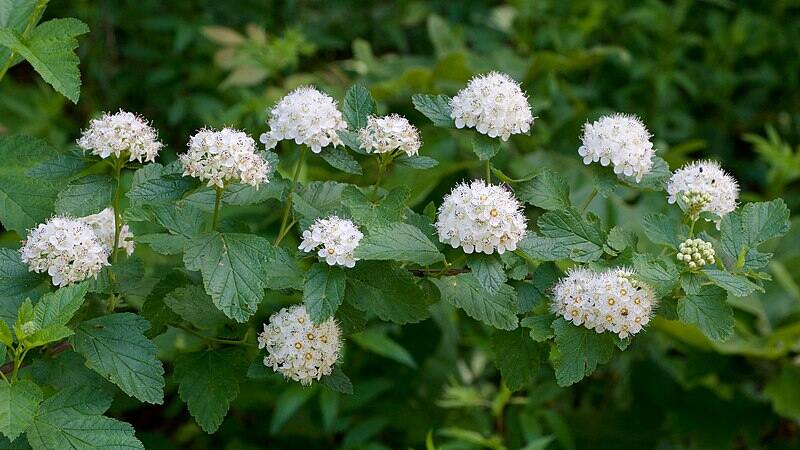
Photo Credit: Eric Hunt / Wikimedia Commons / CC BY-SA 4.0
Physocarpus opulifolius, sometimes known as ninebark, is a tall, fast-growing shrub native to Missouri. It gets its name from the peeling bark that comes off in layers as the shrub matures. This flowering shrub blooms in spring, attracting a host of bees, birds, butterflies, and other pollinators to its nectar-rich flowers.
A deciduous shrub, ninebark’s green leaves change to yellow and red in the fall. A few cultivars, such as ‘Dart’s Gold’ and Summer Wine, display golden or red leaves from spring to fall.
Ideal for: Mass plantings, floral privacy hedges, borders, xeriscaping, or erosion control on banks. With its arching growth pattern, ninebark is a visually charming, low-maintenance addition to a landscape.
Growth rate: Fast; can mature in one year
Maintenance: To maintain its shape and encourage air circulation around the plant, prune your ninebark after it flowers, or no later than mid-August. Water shrubs when they’re young, at least once or twice a week during the summer.
Growing notes: Deciduous. Space ninebark 3 to 6 feet apart, depending on the cultivar. Read the nursery labels to determine the spacing suggestions for your plant.
- Hardiness zone: 2-8
- Sun: Needs full sun to partial shade
- Soil: Prefers acidic, loamy soil or clay
- Mature size: 5-8 feet tall, 4-6 feet wide
- Flowers/fruit: Round, fuzzy pink and white flowers in spring
- Drought tolerant: Yes, once established
- Possible problems: Fireblight, powdery mildew, and leaf spots are all possible problems.
11. Yellow-Twig Dogwoods: Best for Winter Interest
Cornus sericea ‘Flaviramea’
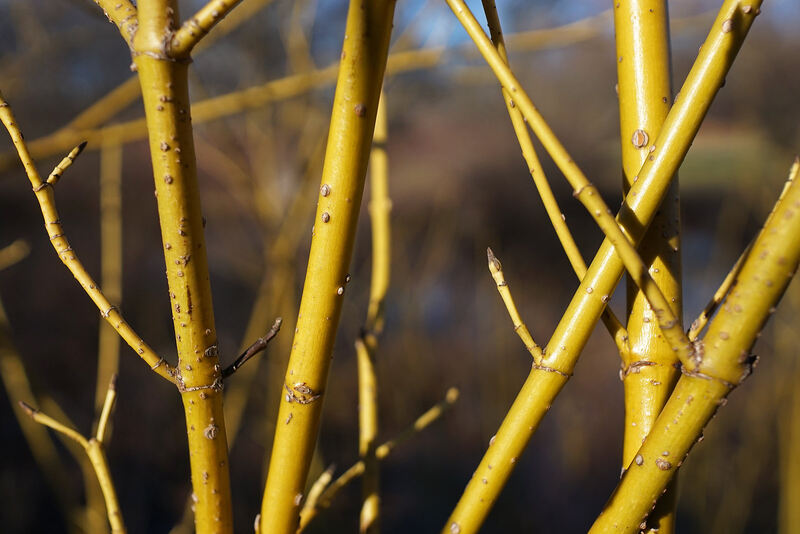
Photo Credit: Plant Image Library / Flickr / CC BY-SA 2.0
Yellow-twig dogwoods are a classic North American native shrub that liven up the cold, wintry months with vibrant yellow twigs. In spring, the yellow twigs of Cornus sericea ‘Flaviramea’ put forth green and emerald foliage accented by white blooms that grow in clusters and develop into white berries.
Because of how fast it grows, you won’t have to wait long for this flowering shrub to draw attention to your garden no matter the time of year.
Ideal for: Hedge, privacy screen, rain garden, mass planting, and erosion control
Growth rate: Fast
Maintenance: Prune in late winter to early spring to maintain airflow, health, and shape. Water at least once a week to keep the soil evenly moist.
Growing notes: Deciduous. Space the shrubs 3 feet apart. To make a hedge, measure from the center of one plant to the center of the next. A deer-resistant shrub, Cornus sericea grows well in cooler climates, as high heat and drought are hard on this cultivar.
- Hardiness zone: 3-8
- Sun: Needs full sun to part shade
- Soil: Prefers moist or wet soils, but tolerant of many soil types
- Mature size: 6-8 feet tall, 7-8 feet wide
- Flowers/fruit: Blooms in spring with 2-inch floral clusters of tiny, white flowers. The berries are attractive to birds but should not be eaten by people.
- Drought tolerant: No
- Possible problems: Leaf and twig blights, canker, and leaf spots are possibilities. Insect pests that appear on occasion include scale, leaf miners, and bagworms.
How to Plan and Plant Privacy Hedges
Before you run to the garden shop, dig a toe into your turf and put a finger on the wind. In other words, grab a soil test and take stock of your local climate. This will go a long way in deciding which type of plant will work for your hedge.
Pro Tip: To avoid running into underground utility lines, call 811 or visit the website at least three business days before you start digging. They’ll mark the locations of utilities for you at no charge.
1. Design Your Look
Think of the overall look and function you want with your privacy fence. No matter if you want to protect your home or create a ‘Bridgerton’-style garden, planning will save you time, money, and effort.
Location is crucial when planting a hedge. The borders and edges of your property are prime locations. Traffic from people and animal activity will damage or stunt your living fence if something gets in its way.
Pro Tip: Keep in mind the mature width of the shrubs when you plant so their growth won’t interfere with existing structures. Make sure you have enough room to prune and water.
2. Think About Height
If you want to build a living fence for security or privacy, it should be at least 6 feet tall. Nonetheless, when developing your plan, you should adhere to the height restrictions imposed by your city or local council.
Decide how tall you want your screen. Place a ladder or have someone stand where you plan on placing your hedge. Taller hedges are more difficult to maintain and require different hedge trimmers than smaller ones.
3. Select Your Plant
Now that you know how much space you have and how tall you want your screen to be, you can select your plant.
Evergreens are excellent all year round for noise reduction and privacy. Although deciduous trees do not provide a year-round screen, they give a larger variety of landscape characteristics, such as fall colors and flowers in the spring. Mix and match your privacy hedge ideas to create a unique look for your yard.
A hybrid hedge fulfills all of the functions of a single plant hedge while giving an aesthetic touch to your property that is distinctive throughout the year. Nature-inspired mixed hedges, as compared to traditional single-variety hedges, provide a range of hues, textures, and patterns.
Ask your local Extension office which species work well in your area.
4. Make Your Plan
You are now ready to lay out the location of your plants. Leave enough space between your plants for them to grow to the size you want.
Make certain that you have a straight row or rows by inserting wooden stakes into the ground at either end and connecting them with a string. Mark the locations of your holes with flags or other indicators.
5. Plant Your Hedge
When planting bare root plants, it is recommended to dig a straight trench for hedges. Individual holes are appropriate for containerized plants. However, either way is acceptable.
6. Water Your Shrubs
Water your shrub as soon as you plant it. For most bushes, 30 seconds of continuous water from a water hose equipped with a diffuser nozzle is enough. Make certain that the soil around your new plants is moist. This encourages the roots to form a root system inside this backfill soil.
During the first few summers, your freshly planted tree expends a lot of energy attempting to establish its roots in the soil. It’s important to know when and how much water to use:
How often: Freshly planted shrubs and trees require consistent, routine watering until their root systems are established. You might consider the cost of installing a sprinkler system to handle this chore automatically.
- For 1 to 2 weeks: Water your new plants daily.
- For up to 3 months: Water every two or three days, keeping the soil moist but not soggy.
- After 3 months: Watering once a week should be enough until your bush is established.
How much: To water newly planted trees, provide 1-1.5 gallons of water for every inch the trunk is wide. Larger shrubs will require more time for the roots to establish.
Water By Trunk Size
| Trunk Width | Water Amount (per watering) | Time to Establish Roots |
| 1 inch | 1 to 1.5 gallons | 1.5 years |
| 2 inches | 2 to 3 gallons | 3 years |
| 3 inches | 3 to 4.5 gallons | 4.5 years |
| 4 inches | 4 to 6 gallons | 6 years |
| 5 inches | 5 to 7.5 gallons | 7.5 years |
| 6 inches | 6 to 9 gallons | 9 years |
University of Minnesota Extension
All you have left is to plant your hedge and see how fast it grows. Growing hedge plants for privacy will enhance the security and seclusion of your home while providing an eco-friendly way to increase your home’s curb appeal.
FAQ
How Far From a Wall Should My Hedge Be?
Plant at least 18 to 24 inches away for traditional or hybrid hedges. If you’re growing a very tall living fence, you’ll need to calculate the plant spacing based on how wide the plants will grow.
How Do I Make My Growing Hedge Denser?
The simple solution is to clip/prune the young hedge to promote thickening. Pruning methods vary according to the species. Cherry laurel, hollies, and yew plum pine will require careful pruning. For detailed information on how to help your hedge grow thick and dense, consult our detailed guide: Pruning 101: How to Trim Bushes, Hedges, and Shrubs.
Why Should I Get a Soil Test?
Soils in poor condition do not retain enough nutrients and water to support healthy plant development. Having that information in hand helps provide the basis for appropriate soil amendments. Matthew Kiefer, CLM, principal of Kiefer Landscapes, says, “It’s really an excellent and inexpensive investment.”
When to Call a Pro
Adding a few hedges to your yard will turn your property into a quiet sanctuary, a romantic garden, or just block out those noisy neighbors. If planning, planting, and pruning your living fence doesn’t sound like an ideal weekend, reach out to one of our local landscaping pros today to handle the dirty work.
Main Image Credit: Agnieszka Kwiecień, Nova / Wikimedia Commons / CC BY-SA 4.0